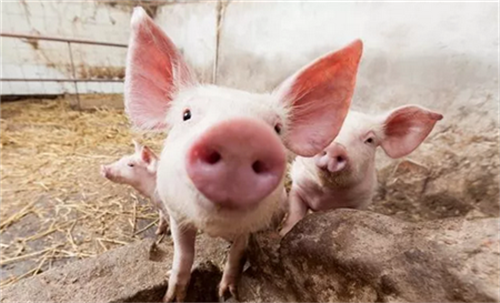So this is what causes pig belly breathing!
I. the causes of abdominal breathing
Porcine infectious pleurisy
Porcine infectious pleurisy is a common respiratory infectious disease, its main pathological changes are pneumonia and pleurisy, the disease will make pigs highly dyspnea, lead to abdominal breathing, and even cause acute septicemia and sudden death in pigs.
Porcine infectious pleuropneumonia
1. Porcine infectious pleuropneumonia is the most acute type of sudden onset, which will increase body temperature, heart rate, depression and loss of appetite, resulting in diarrhea and vomiting symptoms, but not for long.
2. Although there are no obvious respiratory symptoms in early diseased pigs, heart failure, cyanosis of nose, ears, eyes and hindquarters skin will occur in the later stage of porcine infectious pleuropneumonia, resulting in extreme difficulty in breathing in the late stage, opening mouth and tongue, coughing and wheezing, and abdominal breathing. Before death, there will be symptoms of hypothermia, and in severe cases, foam and bloody secretions will flow out of the mouth and nose.
3. Most pigs with infectious porcine pleuropneumonia die within 24-36 hours after the onset of symptoms, and the mortality rate is as high as 80% / 100%.

Second, choose the treatment according to the situation.
Treatment of porcine infectious pleurisy: penicillin, chloramphenicol and sulfamethoxazole (sulfamethoxazole) are generally the first choice of drugs. Injection method must be selected for the first treatment, and the amount of treatment should be larger. If the combination is added in drinks and drinking water, the effect will be better.
Note: do not use chloramphenicol for too long; when taking sulfamethoxazole, you should cooperate with the same amount of sodium bicarbonate (baking soda), long-acting oxytetracycline, Demixian and so on.
For the treatment of infectious pleuropneumonia: florfenomycin was injected intramuscularly or intrapleural for more than 3 days, and the feed was mixed with Zhiyuanjing, doxycycline, florfenomycin or Beilimycin for 5 to 7 days.
Note: if there are conditions, it is best to do drug sensitivity test, select sensitive drugs for treatment, although the treatment of antibiotics has achieved some success in clinical practice, but it can not eliminate infection in pigs.
If the pig has abdominal breathing, but the body temperature is normal.
Principle of treatment: sick pigs with this condition show chronic diseases, the course of disease is long, and the physique of pigs is poor, so it is not suitable to choose drugs with great side effects such as tilmicosin, because the target organ of the side effects of timi is the heart, which can cause tachycardia and weakening of contractility, which can easily cause the death of pigs after injection.
Lincomycin isotherm sensitive antibiotics plus dexamethasone can be used to prevent shock, while ammonia insertion is used to relieve asthma on the other side, lincomycin (10mg/kg) + dexamethasone (1mg/15kg) is injected intramuscularly on one side and aminophylline (0.5g at a time) is injected on the other side, once in the morning and afternoon for 2-3 days, and the dose of ground rice is halved the next day.
If the pig has asthma, cough or fever
Treatment principle: use mild antipyretic drugs such as Shuanghuanglian and flunisine meglumine, avoid aminopyrine and analgin as far as possible, and die of shock due to a sudden drop in temperature due to forced antipyretic, combined with sensitive antibiotics.
Florfenicol or lincomycin or tilmicosin + Shuanghuanglian was injected intramuscularly on one side, and aminophylline on the other side (0.5g at a time).
Points for attention in medication
1. The efficacy of millet and aminophylline is maintained for a short time. The drug must be used once in the morning and afternoon for 2-3 days until the pig's breathing is normal.
2. Aminophylline has good antiasthmatic effect. When used with antibiotics, aminophylline can effectively control wheezing, but when combined with lincomycin, it can reduce the clearance rate of aminophylline in liver, increase blood concentration and even cause toxic reaction. When using, the dose is strictly controlled, and the pig dose is 0.25-0.5g at a time.
3. When treating abdominal breathing, dexamethasone can effectively absorb inflammatory secretions from the lungs and keep the respiratory tract of pigs unobstructed. The dose of millet should be gradually reduced, and the dose of antibiotics will remain unchanged until the inflammation disappears to prevent recurrence of the disease.
Related
- On the eggshell is a badge full of pride. British Poultry Egg Market and Consumer observation
- British study: 72% of Britons are willing to buy native eggs raised by insects
- Guidelines for friendly egg production revised the increase of space in chicken sheds can not be forced to change feathers and lay eggs.
- Risk of delay in customs clearance Australia suspends lobster exports to China
- Pig semen-the Vector of virus Transmission (4)
- Pig semen-the Vector of virus Transmission (3)
- Five common causes of difficult control of classical swine fever in clinic and their countermeasures
- Foot-and-mouth disease is the most effective way to prevent it!
- PED is the number one killer of piglets and has to be guarded against in autumn and winter.
- What is "yellow fat pig"? Have you ever heard the pig collector talk about "yellow fat pig"?



